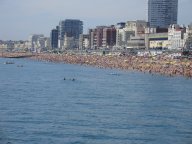 Along the coast can be found a number of seaside resorts including: Brighton, Hastings, Eastbourne, Bexhill, Seaford, Shoreham-by-Sea, Worthing, Littlehampton and Bognor.
Along the coast can be found a number of seaside resorts including: Brighton, Hastings, Eastbourne, Bexhill, Seaford, Shoreham-by-Sea, Worthing, Littlehampton and Bognor.
Sussex is a county on the south coast of England. It corresponds roughly to the ancient Kingdom of Sussex. For administrative purposes it is divided into East and West Sussex, but most people refer to the county as Sussex.
The predominant feature of the countryside is the South Downs, a chalk escarpment running from East to West. At the end of March 2009, 60 years after the idea was first proposed, the South Downs, the line of hills running along the south coast, was declared a National Park.
Running parallel to the South Downs in neighbouring Surrey lies the North Downs.
The Weald lies between the North and South Downs. In the Middle Ages, the Weald was important for wood and its iron works.
Sussex is good for walking. Long distance routes running through the county include: The South Downs Way, Sussex Border Path, Mid-Sussex Link, Sussex Coast Path.
Sussex has a number of marshes, the most important being Romney Marsh.
The South Downs meet the sea in dramatic chalk cliffs at Beachy Head and the Seven Sisters.
 Along the coast can be found a number of seaside resorts including: Brighton, Hastings, Eastbourne, Bexhill, Seaford, Shoreham-by-Sea, Worthing, Littlehampton and Bognor.
Along the coast can be found a number of seaside resorts including: Brighton, Hastings, Eastbourne, Bexhill, Seaford, Shoreham-by-Sea, Worthing, Littlehampton and Bognor.
Hastings, as every schoolboy knows, is where the Battle of Hastings took place in 1066. Hastings is typical of many English seaside resorts, run down and long past its sell-by-date. It has a high proportion of homeless and low income families.
As every schoolboy knows, the Battle of Hastings, 1066 and all that, took place at Hastings. Well actually it didn't, it took place outside of Hastings at nearby Battle. King William vowed if he won, he'd build an Abbey to commemorate the victory, and true to his word, he had built Battle Abbey. The Abbey now lies in ruins.
Another myth to be demolished, Harold did not die through an arrow through his eye, as depicted in the Bayeux Tapestry, but through an inglorious clubbing around the head.
Brighton became very popular with day-trippers with the arrival of the railway in 1841.
The small town of Rye, one of the Cinque Ports, long abandoned and left high and dry by a fast receding sea, is one of the loveliest of the coastal towns.
Also worth visiting, apart from Rye and nearby Winchelsea overlooking Romney Marsh, are the ancient towns of Arundel and Chichester.
One of the infamous cultural customs of Sussex was Rough Music. In the absence of any legal remedy, locals would engage in a form of rough justice known as Rough Music.
Rough music is a Sussex tradition dating back centuries. It was a form of punishment for those who had offended their communities - people like profiteering landlords, wife-beaters or kiddie-fiddlers. In the past lovely people like these were a lot harder to prosecute using the law, so people took matters into their own hands. Taking what ever they could to make some noise with them, they would stand outside the miscreant's house and make as much noise as possible. If they were successful the offender was often driven out completely. A similar tradition existed in the Lincolnshire village of Washingborough where miscreants would be Ran Tanned, at the time permitted under common law. Although rough music gatherings were illegal they happened throughout Sussex with the last ones recorded as happening as late as the 1950s. Rough Music, a free newsletter of the same name, makes a din.
Rough Music is Brighton's trouble makin', dirt diggin' free monthly newsletter.